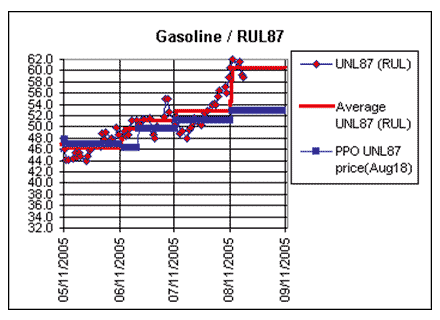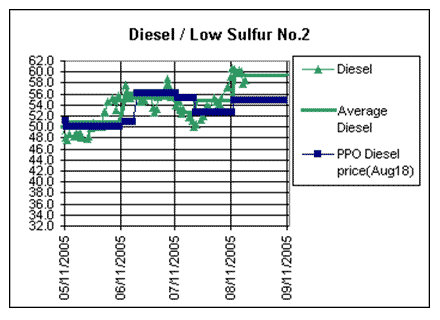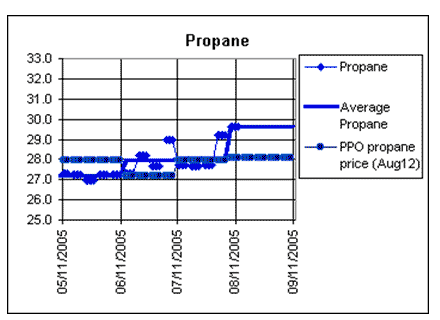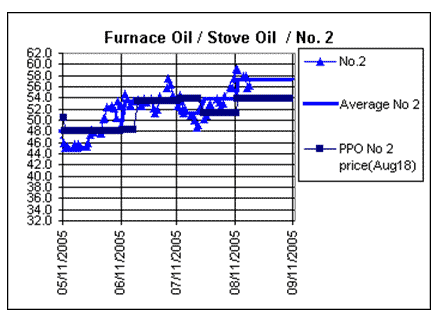NLIS 2
August 22, 2005
(Government Services)
The following is being distributed at
the request of the Public Utilities Board�s Petroleum Pricing Office
(PPO):
Petroleum prices
continue to rise
Effective 12:01 a.m. Monday, August
22, 2005, the Public Utilities Board�s Petroleum Pricing Office (PPO)
will use its interruption formula to make a further adjustment to
the maximum prices of most regulated fuels in Newfoundland and
Labrador.
The maximum price of all types of gasoline will increase by 8.8/8.9
cents per litre (cpl) - depending on the HST rounding effect for a
particular pricing zone, while automotive diesel will rise by 5.4
cpl. There will also be an upward movement in the maximum price of
furnace/stove oil by 3.55 cpl.
There will be no change to the maximum price for residential propane
used for home heating purposes because the criteria for the
interruption formula have not been met.
This adjustment is the result of elevated and aggressive world
market prices for refined fuels that have been sustained since the
last price adjustments were made August 15. The interruption formula
is designed to make interim price changes up or down to account for
volatile behaviour between periods of normal price adjustments made
by the PPO on the 15th of each month. If price fluctuations on the
New York Mercantile Exchange (NYMEX) exceed � 3.5 cpl over a
five-day period then adjustments are made where price increases or
decreases are warranted.
David Toms, PPO director (acting), said in the current
circumstances, the world market continues to be driven by the fear
that demand will outstrip supply, possibly creating a future market
shortfall. Unfortunately for consumers in this situation, prices
continue to move toward unprecedented levels.
�High fuel prices are not isolated to this province; this is a
global problem forcing petroleum prices to record levels in Canada,
U.S. and worldwide,� said Mr. Toms.
REACTIVE MARKETPLACE
In the first few days of this pricing period, the market remained
reactive to events that were occurring in the Middle East, such as
Iran�s (OPEC�s � Organization of Petroleum Exporting Countries �
second-largest oil producer) plan to resume its nuclear program and
the potential for diplomatic dispute.
Continued unrest in major oil-producing countries, such as Iraq,
Saudi Arabia, Venezuela, Nigeria and the latest in Ecuador, where
protests have shut 200 oil wells and slashed output at the
state-owned oil company, have stimulated fears of potential fuel
supply disruptions.
Ongoing refinery shutdowns and production problems, during a time
when many were operating at near-maximum capacity, also created
concern on the market that there will be insufficient products to
meet expected demand. This has led to record prices for refined
fuels, such as gasoline, in advance of the Labour Day weekend, a
peak driving time.
The U.S. Energy Information Administration (EIA) released its weekly
inventory report August 17, and indicated that although gasoline
stockpiles had decreased by a larger-than-expected amount, the
futures for this fuel were at an all-time high causing a decline in
market prices. As well, oil and distillate fuel (furnace/stove oil
and diesel) inventories were reportedly on the rise. This marked the
first day in a long time the market saw any relief.
OPEC has increased its forecast for world oil demand growth next
year, and stated it would have to offset any diminished output from
non-OPEC members with its own increased production. Improved
economies in the U.S. and China have been named contributors to this
projected increase.
BACKGROUNDER
PPO benchmarks are established based
on the average prices of refined products in the
period since the last time maximum prices were established. The PPO
regularly sets maximum fuel prices on the 15th of each month.
For the interruption formula to be used on gasoline and distillate
fuels, the PPO requires the average of market prices to be 3.5 cpl
greater or less than the current PPO benchmark
prices (except propane, which requires +/- 5.0 cpl) over five market
business days. The formula is not used for five market days after
new prices are set under regulation, or if it interferes with the
impending price change made each month.
Illustrated in the following graphs is the market-price performance
for fuels regulated by the PPO for recent pricing periods up to
August 18, 2005:




1. Automotive Fuels � Maximum Retail Pump
Prices � Effective August 22, 2005
2. Heating Fuels � Maximum Tank Wagon
(**Tank Farm) Prices � Effective August 22, 2005
Media contact: Michelle Hicks, Communications. Tel: 1-866-489-8800
or (709) 489-8837.
2005 08 22
10:05 a.m. |








